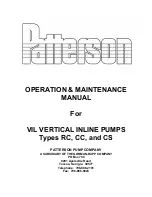
14
GB
D
F
E
I
NL
P
GR
RU
TR
CZ
SV
SL
HG
PO
10.4. Thermal insulation of refrigerant piping
Be sure to add insulation work to refrigerant piping by covering liquid pipe and gas
pipe separately with enough thickness heat-resistant polyethylene, so that no gap
is observed in the joint between indoor unit and insulating material, and insulating
materials themselves. When insulation work is insufficient, there is a possibility of
condensation drip, etc. Pay special attention to insulation work in the ceiling ple-
num.
[Fig. 10.4.1]
C
A
B
D
E
A
Steel wire
B
Piping
C
Oily mastic asphalt or asphalt
D
Heat insulation material A
E
Outer covering B
Note:
•
When using polyethylene cover as covering material, asphalt roofing shall
not be required.
•
No heat insulation must be provided for electric wires.
[Fig. 10.4.2]
B
A
D
C
E
E
E
D
A
B
A
Liquid pipe
B
Gas pipe
C
Electric wire
D
Finishing tape
E
Insulator
[Fig. 10.4.3]
Heat
insulation
material A
Outer
covering B
Glass fiber + Steel wire
Ad Heat - resistant polyethylene foam + Adhesive tape
Indoor
Vinyl tape
Floor exposed
Water-proof hemp cloth + Bronze asphalt
Outdoor
Water-proof hemp cloth + Zinc plate + Oily paint
Penetrations
[Fig. 10.4.4]
(Unit: mm [in])
<A> Inner wall (concealed)
<B> Outer wall
A B
A B
D
C
<C> Outer wall (exposed)
<D> Floor (waterproofing)
E
I
B
D
F
G
B
<E> Roof pipe shaft
<F> Penetrating portion on fire limit and
boundary wall
F
H
D
B
G
I
A
J
1000
1000
[39-3/8]
[39-3/8]
A
Sleeve
B
Heat insulating material
C
Lagging
D
Caulking material
E
Band
F
Waterproofing layer
G
Sleeve with edge
H
Lagging material
I
Mortar or other incombustible caulking
J
Incombustible heat insulation material
When filling a gap with mortar, cover the penetration part with steel plate so that
the insulation material will not be caved in. For this part, use incombustible materi-
als for both insulation and covering. (Vinyl covering should not be used.)
•
Insulation materials for the pipes to be added on site must meet the following
specifications:
*
Installation of pipes in a high-temperature high-humidity environment, such as
the top floor of a building, may require the use of insulation materials thicker
than the ones specified in the chart above.
*
When certain specifications presented by the client must be met, ensure that
they also meet the specifications on the chart above.
Thickness
Temperature Resistance
Pipe size
ø6.35 to 25.4 mm [1/4 to 1 in]
10 mm min. [13/32 in min.]
100°C min. [212°F min.]
ø28.58 to 41.28 mm [1-1/8 to 1-21/32 in]
15 mm min. [19/32 in min.]
11. Wiring
(For details, refer to the installation manual of each indoor/outdoor unit and controller.)
11.1. Caution
1
Follow ordinance of your governmental organization for technical standard re-
lated to electrical equipment, wiring regulations and guidance of each electric
power company.
2
Wiring for control (hereinafter referred to as transmission line) shall be (5 cm or
more [2 in or more]) apart from power source wiring so that it is not influenced
by electric noise from power source wiring. (Do not insert transmission line
and power source wire in the same conduit.)
3
Be sure to provide designated grounding work to the outdoor unit.
4
Give some allowance to wiring for the electrical part box on the indoor and
outdoor units, because these boxes are sometimes removed at the time of
service work.
5
Never connect the main power source to terminal block of transmission line. If
connected, electrical parts will burn out.
6
Use 2-core shield cable for the transmission line. If transmission lines of differ-
ent systems are wired with the same multiplecore cable, the resultant poor
transmitting and receiving will cause erroneous operations.
7
Only the transmission line specified should be connected to the terminal block
for outdoor unit transmission.
Erroneous connection does not allow the system to operate.
8
When connecting a System Controller to outdoor units or performing a group
operation of indoor units that are connected to different outdoor units, a trans-
mission line for centralized control is required. When using a transmission line
for centralized control, connect the transmission line (non-polar 2 core wire) to
all TB7 terminals between all outdoor units.
9
Grouping is set by operating the remote controller.
11.2. Control box and connecting position of wiring
1
Outdoor unit
1. Remove the front panel of the control box by removing the 4 screws and push-
ing it up a little before pulling it out.
2. Connect the indoor - outdoor transmission line to the terminal block (TB3) for
the indoor - outdoor transmission line.
If multiple outdoor units are connected in the same refrigerant system, daisy-
chain TB3 (M1, M2, ground terminal
) on the outdoor units. Connect the
indoor - outdoor transmission line for the outdoor units to TB3 (M1, M2, ground
terminal
) of only one of the outdoor units.
3. Connect the transmission lines for centralized control (between the centralized
control system and the outdoor unit of different refrigerant systems) to the
terminal block for centralized control (TB7). If the multiple outdoor units are
connected to the same refrigerant system, daisy-chain TB7 (M1, M2, S Termi-
nal) on the outdoor units in the same refrigerant system. (*1)















































